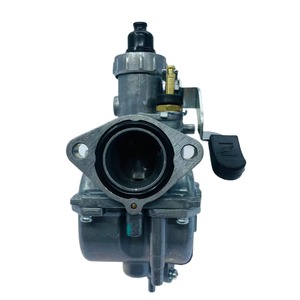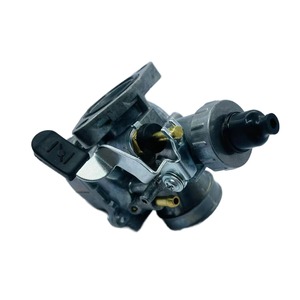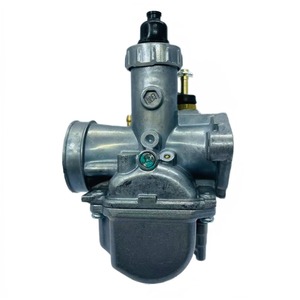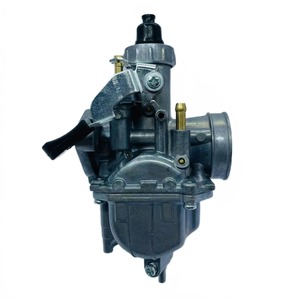(2606 products available)


















































































































































































































Mikuni is a brand name of carburetors, widely used in motorcycles, ATVs, watercraft, snowmobiles, and other small engines. Carburetors are mechanical devices that mix air and fuel in internal combustion engines. Mikuni carburetors are known for their precision engineering, reliability, and performance. They are used to control the mixture of air and fuel in the engine, ensuring optimal combustion and efficient performance.
There are several types of Mikuni carburetors, each designed for specific applications and performance requirements. Here are some common types:
BDL Carburetor
The Mikuni BDL carburetor is a constant vacuum carburetor. It has a throttle valve controlled by a spring and a vacuum-operated diaphragm. As the engine speed increases, the vacuum in the carburetor body rises, pulling the diaphragm and opening the throttle valve. This design allows for precise control of the air-fuel mixture, ensuring optimal performance across a wide range of engine speeds. BDL carburetors are commonly used in high-performance applications, such as racing motorcycles and performance ATVs.
VM Carburetor
The Mikuni VM carburetor is a constant-level float carburetor. It features a float chamber that maintains a constant fuel level, allowing for precise control of the fuel metering. VM carburetors are known for their reliability and consistent performance, making them suitable for various applications, including street motorcycles, off-road bikes, and utility vehicles. The VM carburetor's design ensures smooth throttle response and stable power delivery, making it a popular choice among riders and engine manufacturers.
BS Carburetor
The Mikuni BS carburetor is a diaphragm-type constant vacuum carburetor. It is similar to the BDL carburetor but incorporates a diaphragm chamber to provide more precise control over the air-fuel mixture. The BS carburetor is widely used in small engines, such as lawnmowers, chainsaws, and outboard motors. Its diaphragm design compensates for changes in altitude and temperature, ensuring reliable starting and smooth operation in various conditions.
HSR Carburetor
The Mikuni HSR carburetor is a high-performance flat-slide carburetor. It features a flat throttle slide valve that provides excellent throttle response and increased airflow, making it suitable for high-performance applications. HSR carburetors are commonly used in racing motorcycles, custom choppers, and high-performance ATVs. The flat-slide design minimizes turbulence in the airflow, resulting in improved acceleration and top-end power. HSR carburetors can be tuned for specific performance requirements, making them a favorite among racers and performance enthusiasts.
Mikuni carburetors have various specifications that suit different engine requirements. Here are some general specifications of Mikuni carburetors:
Jetting
Jetting includes the main, pilot, needle jet, and enrichener jets. The carburetor's jetting controls the fuel flow and determines the air-fuel ratio. The main jet ranges from 100 to 300 or more, while the pilot jet is between 15 to 40. The needle jet measures 0.20 to 0.40 mm or more, and the enrichener jet is 0.50 to 1.00 mm.
Throttle Bore Size
Throttle bore size is the diameter of the carburetor's throttle body. It determines the air intake and affects the engine's power delivery. The throttle bore size ranges from 26 mm to 50 mm or more.
Slide Size
Slide size controls the carburetor's response to throttle movements. It influences the engine's low-end and mid-range power delivery. Mikuni carburetors have slide sizes that range from 10 mm to 30 mm. Slide sizes are usually equal to the slide valve diameter.
Needle Size
Needle size controls the fuel metering in the transition between the pilot and main jet. It affects the engine's response to throttle opening. Needle sizes range from 2.5 to 3.5 mm or more in diameter.
Float Height
Float height is an important specification in Mikuni carburetors. It influences fuel level in the float chamber, which affects fuel delivery and the air-fuel ratio. The float height ranges from 20 to 30 mm or more.
Maintaining Mikuni carburetors is important to ensure optimal engine performance. Here are some general maintenance tips for Mikuni carburetors:
Regular Cleaning
Disassemble the carburetor and clean it with a carburetor cleaner. Rinse all parts in a solvent to remove deposits and dirt.
Inspect for wear and damage
Check for worn or damaged components, such as gaskets, O-rings, and jets. Replace damaged parts to maintain the carburetor's integrity.
Check and Adjust
Check and adjust the float height, needle and seat, air screw, and mixture screw. Ensure they are within the specified range for optimal performance.
Lubricate
Apply a small amount of lubricant to the throttle linkage and other moving parts of the carburetor to ensure smooth operation.
Use Fresh Fuel
Use fresh fuel with the recommended octane rating for the engine. Avoid using stale fuel or fuel with high ethanol content, damaging the carburetor components.
Winterization
If not used for a long time, perform winterization. Drain the fuel from the carburetor and add a fuel stabilizer to prevent fuel deterioration and carburetor damage.
When sourcing Mikuni carburetors, consider the following:
Application
Identify the intended use or market segment, such as motorcycle enthusiasts, ATV owners, or marine applications. Different user groups may prefer specific Mikuni models optimized for their vehicles' performance needs.
Model Selection
Research popular Mikuni carburetor models associated with various vehicle makes and models. Understand the specifications and advantages of each model to align with the demand of targeted customer segments.
Performance Tuning
Consider offering tuning kits or components separately to cater to customers seeking customized performance. Research common tuning preferences among user groups and stock relevant Mikuni tuning parts.
Market Trends
Keep abreast of emerging trends in the aftermarket carburetor industry. For instance, there may be a growing interest in eco-friendly solutions or products that improve fuel efficiency. Mikuni's innovations in response to such trends could be relevant to the target audience.
Brand Reputation
Evaluate the brand reputation of Mikuni carburetors among different customer groups. Look for customer reviews, testimonials, and case studies to gauge satisfaction levels and identify areas for improvement.
Competitive Analysis
Analyze competitors offering similar products in the target market. Understand their pricing strategies, product offerings, and value-added services. Identify gaps in the market that can be leveraged to gain a competitive advantage.
After-Sales Support
Evaluate the availability of spare parts, tuning components, and accessories for the selected Mikuni carburetor models. Ensure that after-sales support can be provided to customers, including technical assistance and warranty services.
Marketing Strategy
Develop a comprehensive marketing strategy to promote the sourced Mikuni carburetors. Highlight the unique selling propositions (USPs) of the selected models and create targeted campaigns to reach the desired customer segments.
Replacing Mikuni carburetors can be a simple process. Here are some steps on how to replace Mikuni carburetors:
Q1. Where are Mikuni carburetors made?
A1. Mikuni carburetors are made in Japan, and Mikuni is the original manufacturer.
Q2. What is the function of a Mikuni carburetor?
A2. Mikuni carburetors are used in engines to mix air and fuel in the right proportions to ensure proper combustion. This ensures that the engine runs smoothly and efficiently.
Q3. Are Mikuni carburetors good?
A3. Yes, Mikuni carburetors are generally considered good and high-quality. They are known for their precision engineering, reliability, and excellent performance in fuel metering, which makes them a popular choice for many applications, including motorcycles, outboard motors, and other small engines.
However, the quality and performance of Mikuni carburetors can also depend on factors such as proper installation, maintenance, and tuning, which are crucial for optimal performance.
Q4. What is the difference between Mikuni BS and S?
A4. Mikuni carburetor instructions bs and s differ in their design and technical features. While BS is a constant vacuum carburetor, Mikuni S is a split-carburetor design. Also, Mikuni BS is often used in larger engines, while S is commonly used in smaller engines.